
Concept explainers
Top ten video games: According to Wikipedia, the following are the top ten selling video games of all time.
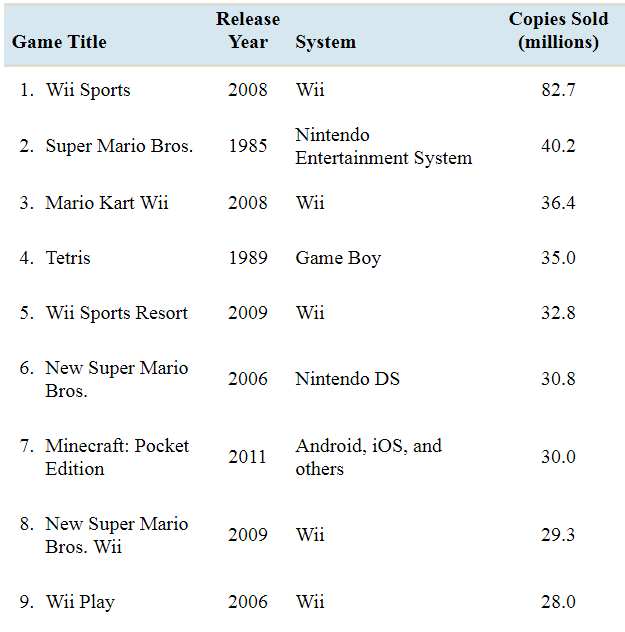

- Which of the columns represent qualitative variables?
- Which of the columns represent quantitative variables?
- Which of the columns represent nominal variables?
- Which of the columns represent ordinal variables?
a.
To identify:the columns that represent qualitative variables.
Answer to Problem 47E
The columns Game Title and System represent qualitative variables.
Explanation of Solution
Given information:
| Game Title | Release Year | System | Copies Sold (millions) |
| 1. 1. Wii Sports | 2008 | Wii | 82.7 |
| 2. 2. Super Mario Bros. | 1985 | Nintendo Entertainment System | 40.2 |
| 3. 3. Mario Kart Wii | 2008 | Wii | 36.4 |
| 4. 4. Tetris | 1989 | Game Boy | 35.0 |
| 5. 5. Wii Sports Resort | 2009 | Wii | 32.8 |
| 6. 6. New Super Mario Bros | 2006 | Nintendo DS | 30.8 |
| 7. 7. Minecraft: Pocket Edition | 2011 | Android, iOS, and others | 30.0 |
| 8. 8. New Super Mario Bros. Wii | 2009 | Wii | 29.3 |
| 9. 9. Wii Play | 2006 | Wii | 28.0 |
| 10. 10. Kinect Adventures | 2010 | Xbox 360 | 24.0 |
Concept Involved:
There are various methods of collecting information by sampling. Once the information has been collected, the collection is called a data set. Variables can be divided into two types: qualitative and quantitative. Qualitative variables are also called categorical variable, classify individuals into categories. Quantitative variables are numerical and tell how much of something there is.
Qualitative variables come in two types: ordinal variables and nominal variables.
Ordinal variables are qualitative variables whose categories have a natural ordering.
Nominal variables are qualitative variables whose categories have no natural ordering.
Quantitative variables can be either discrete or continuous.
Discrete variables are those whose possible values can be listed. Often, discrete variables result from counting something, so the possible values of the variable are 0, 1, 2 and so forth.
Continuous variables can, in principle, take on any value within some interval.
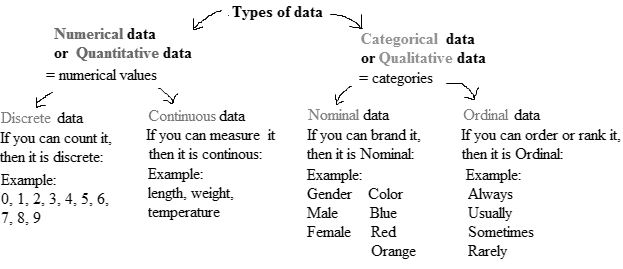
The variable which classifies individuals into categories is called qualitative variable, and the variable which provide information about quantity or number of something is quantitative variable. The Game Title and System classifies the top ten selling video games of all time.
Therefore, the columns Game Title and System represent qualitative variables.
b.
To identify:the columns that represent quantitative variables.
Answer to Problem 47E
The columns Copies sold (millions) represent quantitative variables.
Explanation of Solution
Given information:
| Game Title | Release Year | System | Copies Sold (millions) |
| 1. Wii Sports | 2008 | Wii | 82.7 |
| 2. Super Mario Bros. | 1985 | Nintendo Entertainment System | 40.2 |
| 3. Mario Kart Wii | 2008 | Wii | 36.4 |
| 4. Tetris | 1989 | Game Boy | 35.0 |
| 5. Wii Sports Resort | 2009 | Wii | 32.8 |
| 6. New Super Mario Bros | 2006 | Nintendo DS | 30.8 |
| 7. Minecraft: Pocket Edition | 2011 | Android, iOS, and others | 30.0 |
| 8. New Super Mario Bros. Wii | 2009 | Wii | 29.3 |
| 9. Wii Play | 2006 | Wii | 28.0 |
| 10. Kinect Adventures | 2010 | Xbox 360 | 24.0 |
Concept Involved:
There are various methods of collecting information by sampling. Once the information has been collected, the collection is called a data set. Variables can be divided into two types: qualitative and quantitative. Qualitative variables are also called categorical variable, classify individuals into categories. Quantitative variables are numerical and tell how much of something there is.
Qualitative variables come in two types: ordinal variables and nominal variables.
Ordinal variables are qualitative variables whose categories have a natural ordering.
Nominal variables are qualitative variables whose categories have no natural ordering.
Quantitative variables can be either discrete or continuous.
Discrete variables are those whose possible values can be listed. Often, discrete variables result from counting something, so the possible values of the variable are 0, 1, 2 and so forth.
Continuous variables can, in principle, take on any value within some interval.
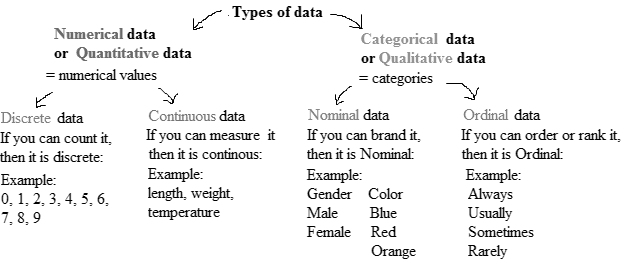
The variable which classifies individuals into categories is called qualitative variable, and the variable which provide information about quantity or number of something is quantitative variable. The column copies sold (in millions) represent how many of something is there.
Therefore, it represents quantitative variable.
c.
To identify:the columns that represent nominal variables.
Answer to Problem 47E
The columns System represent nominal variables.
Explanation of Solution
Given information:
| Game Title | Release Year | System | Copies Sold (millions) |
| 1. Wii Sports | 2008 | Wii | 82.7 |
| 2. Super Mario Bros. | 1985 | Nintendo Entertainment System | 40.2 |
| 3. Mario Kart Wii | 2008 | Wii | 36.4 |
| 4. Tetris | 1989 | Game Boy | 35.0 |
| 5. Wii Sports Resort | 2009 | Wii | 32.8 |
| 6. New Super Mario Bros | 2006 | Nintendo DS | 30.8 |
| 7. Minecraft: Pocket Edition | 2011 | Android, iOS, and others | 30.0 |
| 8. New Super Mario Bros. Wii | 2009 | Wii | 29.3 |
| 9. Wii Play | 2006 | Wii | 28.0 |
| 10. Kinect Adventures | 2010 | Xbox 360 | 24.0 |
Concept Involved:
There are various methods of collecting information by sampling. Once the information has been collected, the collection is called a data set. Variables can be divided into two types: qualitative and quantitative. Qualitative variables are also called categorical variable, classify individuals into categories. Quantitative variables are numerical and tell how much of something there is.
Qualitative variables come in two types: ordinal variables and nominal variables.
Ordinal variables are qualitative variables whose categories have a natural ordering.
Nominal variables are qualitative variables whose categories have no natural ordering.
Quantitative variables can be either discrete or continuous.
Discrete variables are those whose possible values can be listed. Often, discrete variables result from counting something, so the possible values of the variable are 0, 1, 2 and so forth.
Continuous variables can, in principle, take on any value within some interval.
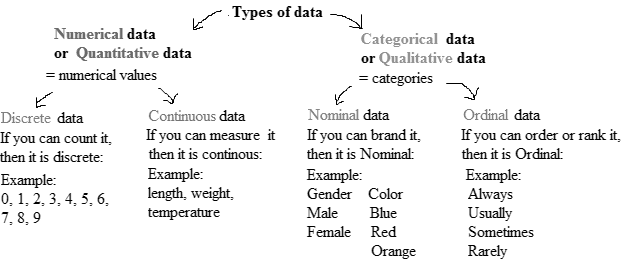
The values are classified into categories in a nominal variable, but no natural ordering is there in categories, whereas, the values are also classified into categories in an ordinary variable but a natural ordering is there in categories.
Therefore, the columns system represents nominal variables.
d.
To identify:the columns that represent ordinal variables.
Answer to Problem 47E
The columns Game Title represent ordinal variables.
Explanation of Solution
Given information:
| Game Title | Release Year | System | Copies Sold (millions) |
| 1. Wii Sports | 2008 | Wii | 82.7 |
| 2. Super Mario Bros. | 1985 | Nintendo Entertainment System | 40.2 |
| 3. Mario Kart Wii | 2008 | Wii | 36.4 |
| 4. Tetris | 1989 | Game Boy | 35.0 |
| 5. Wii Sports Resort | 2009 | Wii | 32.8 |
| 6. New Super Mario Bros | 2006 | Nintendo DS | 30.8 |
| 7. Minecraft: Pocket Edition | 2011 | Android, iOS, and others | 30.0 |
| 8. New Super Mario Bros. Wii | 2009 | Wii | 29.3 |
| 9. Wii Play | 2006 | Wii | 28.0 |
| 10. Kinect Adventures | 2010 | Xbox 360 | 24.0 |
Concept Involved:
There are various methods of collecting information by sampling. Once the information has been collected, the collection is called a data set. Variables can be divided into two types: qualitative and quantitative. Qualitative variables are also called categorical variable, classify individuals into categories. Quantitative variables are numerical and tell how much of something there is.
Qualitative variables come in two types: ordinal variables and nominal variables.
Ordinal variables are qualitative variables whose categories have a natural ordering.
Nominal variables are qualitative variables whose categories have no natural ordering.
Quantitative variables can be either discrete or continuous.
Discrete variables are those whose possible values can be listed. Often, discrete variables result from counting something, so the possible values of the variable are 0, 1, 2 and so forth.
Continuous variables can, in principle, take on any value within some interval.
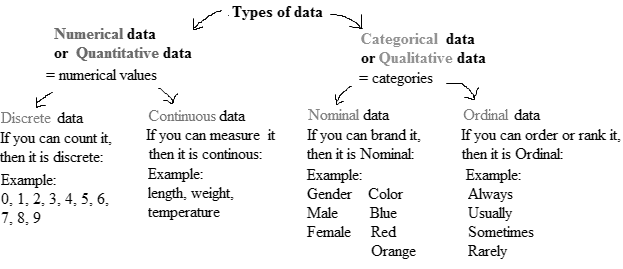
The values are classified into categories in a nominal variable, but no natural ordering is there in categories, whereas, the values are also classified into categories in an ordinary variable but a natural ordering is there in categories.The variable game title classifies the top ten selling video games.
Therefore, column Game Title represents ordinal variables.
Want to see more full solutions like this?
Chapter 1 Solutions
ELEM. STATISTICS TEXT W/ MANUAL+CONNECT
 Holt Mcdougal Larson Pre-algebra: Student Edition...AlgebraISBN:9780547587776Author:HOLT MCDOUGALPublisher:HOLT MCDOUGAL
Holt Mcdougal Larson Pre-algebra: Student Edition...AlgebraISBN:9780547587776Author:HOLT MCDOUGALPublisher:HOLT MCDOUGAL Big Ideas Math A Bridge To Success Algebra 1: Stu...AlgebraISBN:9781680331141Author:HOUGHTON MIFFLIN HARCOURTPublisher:Houghton Mifflin Harcourt
Big Ideas Math A Bridge To Success Algebra 1: Stu...AlgebraISBN:9781680331141Author:HOUGHTON MIFFLIN HARCOURTPublisher:Houghton Mifflin Harcourt Glencoe Algebra 1, Student Edition, 9780079039897...AlgebraISBN:9780079039897Author:CarterPublisher:McGraw Hill
Glencoe Algebra 1, Student Edition, 9780079039897...AlgebraISBN:9780079039897Author:CarterPublisher:McGraw Hill


